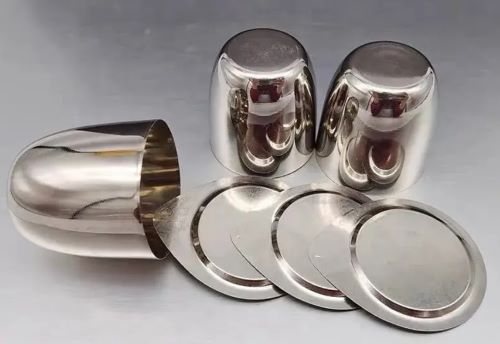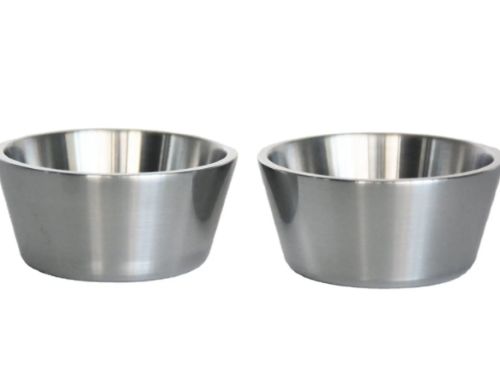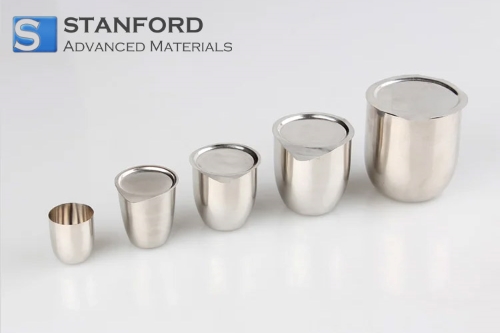Precious vs. Refractory: An Exploration of Metal Crucibles
Introduction
Metal crucibles stand as essential tools in a myriad of industrial and laboratory settings. These devices enhance processes, including precision craftsmanship and metallurgical endeavors. Within this realm, two distinct categories emerge, each tailored to meet specific demands: precious and refractory.
In this comprehensive exploration, we are going to discuss the characteristics, applications, and advantages of these two fascinating branches of crucible technology.
Precious Metal Crucibles: Purity and Precision

Figure 1. Platinum Crucibles
--Materials and Properties:
Precious metal crucibles come from noble metals like platinum, gold, or silver. They epitomize purity and precision. Precious metals possess inherent resistance to corrosion and high melting points. These crucibles ensure the utmost purity of the materials and the precision of the processes.
--Applications:
The applications of precious metal devices often come with the highest standards of purity and precision.
l In jewelry crafting, these crucibles provide a pristine environment for the meticulous casting of precious metals.
l Laboratories that require contamination-free conditions also turn to precious metal crucibles for their inertness and reliability.
--Advantages:
The allure of these crucibles lies in their unique properties. Such features include excellent thermal conductivity, inert nature, and ability to withstand aggressive chemical reactions. In precision applications, the slightest impurity can alter the outcome. So, the purity of precious metals becomes a critical advantage.
--Types and Uses:
Precious metal crucibles serve critical roles in various industrial and laboratory applications. Here are specific applications for each precious metal crucible:
l Used in analytical chemistry for gravimetric analysis and high-temperature reactions;
l Used in high-temperature melting and alloying;
l Can be used up to 1200°C (2192°F);
l Maintains strength at higher temperatures;
l Virtually chemically inert;
l Resist oxidization in the air;
l High corrosion resistance against acids and melted salts;
2. Gold Crucibles:
l Essential in the jewelry industry for melting and casting gold alloys;
l Find use in material science research, particularly in high-temperature reactions and material synthesis;
3. Other Precious Metal Alloys:
l Palladium Crucibles: Utilized in certain laboratory and industrial processes; Similar to platinum;
l Iridium Crucibles: Find use in high-temperature applications and specialized research;
Refractory Metal Crucibles: Withstanding the Harshest Environments

Figure 2. Molybdenum Crucibles
--Materials and Properties:
Contrasting with their precious counterparts, refractory metal crucibles are forged from metals like tungsten, molybdenum, or tantalum. Refractory metals boast high melting points and exceptional mechanical strength. These remarkable features endow them with the ability to withstand extreme temperatures and harsh conditions.
--Applications:
These devices find use in industries where resilience to extreme conditions is paramount.
l In metallurgy, these crucibles find utility in processes involving molten metals. Namely, they can withstand the demanding environment of metal smelting and casting.
l Industries like electronics and research deal with aggressive chemical environments and elevated temperatures frequently. These fields also benefit from the robust nature of refractory metals.
--Advantages:
Such crucibles stand out for their superior resistance to heat, wear, and corrosion. They excel in environments where traditional materials would succumb to harsh conditions. Also, they provide a reliable vessel for processes involving molten metals or aggressive chemical reactions.
--Types and Uses:
Refractory metal crucibles are useful in various industries due to their exceptional properties. Here are specific applications for each crucible:
l Excel in high-temperature melting and casting of metals in metallurgical processes;
l Find use in the production of single crystals;
l Used in chemical reactions, material synthesis, and other laboratory settings for processes requiring corrosion resistance;
l Find use in the production of superalloys for the aerospace industry and beyond;
l Find applications in high-temperature engineering processes;
l Serves as an alloying agent for certain steels;
l Utilized in processes requiring high-temperature melting, such as the production of specialized alloys and single-crystal growth;
l Useful for Vacuum Heat Treatment;
l Can be used up to 450°C (842°F);
l Effective crucible for fusions using sodium carbonate or sodium peroxide;
l Can replace Platinum in many cases;
l Cost-effective for high throughput compared to steel and porcelain;
l Resistant to mixtures of alkaline, carbonate hydroxide, peroxide borate, nitrates, and some fluorites;
l Resistant to nitric acid and sulfuric acid below 75%;
l Not resistant to HF;
6. Nickel Crucibles:
l Can be used up to 800 °C / 1472°F;
l Useful for research, experiments, chemical analysis, tests, quality control, and education;
l Used for single crystal growth of rare earth elements and gemstones;
l Used as a container for anticorrosion, nuclear reaction, and ultra-high evaporation;
Choosing the Right Crucible: Precision or Resilience
The decision between precious and refractory metal crucibles hinges on the specific demands of the intended application. Their inherent properties make them better suited for certain scenarios.
1. Precision and Purity: The Domain of Precious Metals
In applications where precision and purity are paramount, precious metal crucibles take center stage.
l Jewelry artisans, for example, rely on platinum crucibles for casting intricate designs. Therefore, the final product remains untainted by impurities.
l Laboratories engaged in meticulous experiments, particularly those in fields like analytical chemistry, benefit from the inert nature of precious metals as well.
2. Resilience in Extreme Environments: The Realm of Refractory Metals
Industries that contend with extreme temperatures, aggressive chemicals, and demanding physical conditions turn to refractory metal crucibles.
l Metallurgical processes involve the smelting and casting of metals. These procedures demand crucibles that can endure the intense heat generated during these operations. Refractory metals provide the resilience needed for such applications.
l In research and development settings, refractory metals work well, particularly those exploring cutting-edge technologies like aerospace components or advanced materials.
Related reading: What Material Is A Crucible Made Of?
Conclusion
In a word, the choice between precious and refractory is not just about the material. It's about the unique demands of the application. Precious metal crucibles bring a touch of finesse and purity. Meanwhile, refractory metal crucibles stand as stalwart guardians in the face of extreme conditions.
Stanford Advanced Materials (SAM) is a leading supplier of high-purity crucibles. A variety of laboratory crucibles are available on our site. Each type of crucible comes with its distinct properties and advantages. Please check our homepage for the perfect crucible for your research or business.



